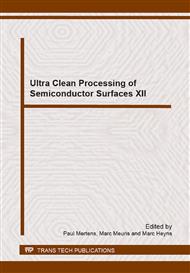p.148
p.153
p.157
p.161
p.165
p.170
p.177
p.183
p.187
Characterization of Cavitation in Ultrasonic or Megasonic Irradiated Gas Saturated Solutions Using a Hydrophone
Abstract:
Emerging ultrasonic and megasonic cleaning demands in various applications (solar cell, storage devices, wafer and mask cleaning, etc.) dictate the need to understand the acoustic cavitation under different operating conditions to optimize efficiency of cleaning and reduce damage. Major parameters that affect cavitation include frequency of the sound field, operating power of the transducer and the cleaning chemistry. Previous studies have reported the use of common techniques such as multi-bubble sonoluminescence [1] and sono-electrochemistry [2] to understand acoustic cavitation. The disadvantage with sonoluminescence technique is that it characterizes cavitation mainly in the bulk of the solution, which may not be pertinent to wafer cleaning applications where the interest is in understanding cavitation phenomena close to the wafer surface. Although, sono-electrochemical techniques employing microelectrode are capable of measuring cavitation in the vicinity of a solid surface, they are limited to measurements on an extremely small area due to the miniscule size (5-25 μm) of the electrode. In this context, hydrophone measurements offer significant benefit as they can be taken near a solid surface as well as on a relative large area (1-2 mm diameter) of the pressure sensitive tip.
Info:
Periodical:
Pages:
165-169
Citation:
Online since:
September 2014
Authors:
Keywords:
Price:
Сopyright:
© 2015 Trans Tech Publications Ltd. All Rights Reserved
Share:
Citation:


